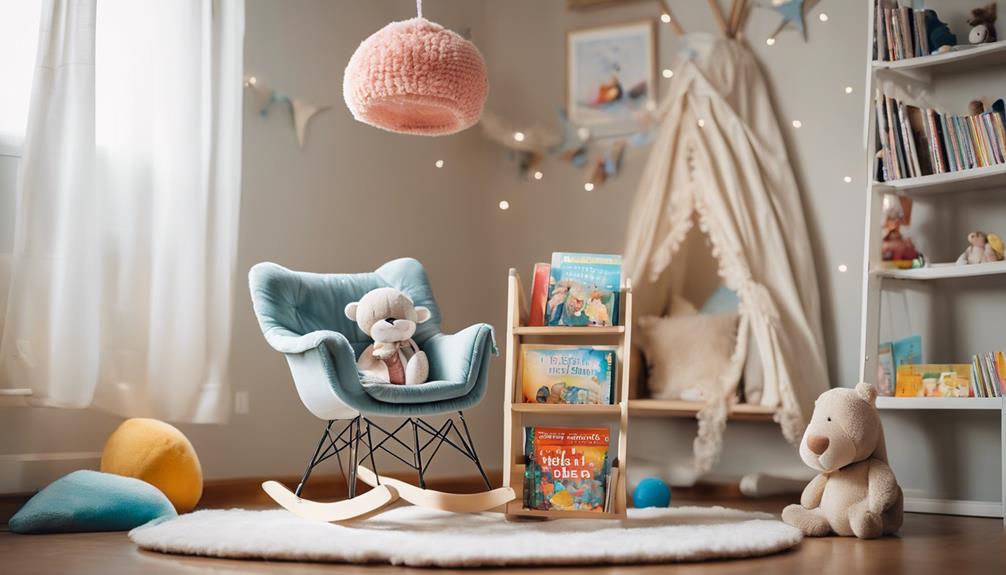To boost your toddler’s language skills, engage in daily conversations, read aloud together, and play with language toys or outdoor objects. Sing songs and rhymes to develop rhythm and memory, and use sensory cues to describe everyday items. Incorporate storytelling and open-ended questions during play, making learning fun and interactive. Keep exploring new words through outdoor adventures—if you want more tips, you’ll find plenty of helpful ideas below.
Key Takeaways
- Engage in daily conversations and read aloud with expressive voices to encourage language development and comprehension.
- Play with language toys like puzzles and alphabet blocks to enhance vocabulary and letter recognition.
- Sing nursery rhymes and use repetitive songs to improve memory, rhythm, and auditory skills.
- Describe and name everyday objects during activities to build vocabulary and understanding through sensory cues.
- Incorporate outdoor exploration and storytelling to expand vocabulary, stimulate curiosity, and promote active learning.
Engaging in Daily Conversation

Engaging your child in daily conversations helps build their language skills and confidence. Start with simple conversation starters that encourage your child to share their thoughts and experiences. Asking questions like, “What did you do today?” or “How does this make you feel?” invites them to speak and practice new vocabulary. Use everyday moments, such as mealtime or walks, to introduce new words and reinforce their meaning. Be patient and listen actively, showing genuine interest in their responses. Incorporating interactive learning tools can further enhance your child’s communication abilities. Remember, unconditional love and support create a safe environment where your child feels comfortable expressing themselves. Consistent, meaningful conversations also support effective communication development, helping your child express ideas clearly and confidently. Incorporating activities like yoga can improve focus and emotional regulation, making communication more effective. Over time, this daily practice boosts their confidence, making them more enthusiastic to communicate and learn new words naturally.
Reading Aloud Together

Have you ever noticed how reading aloud with your child can turn ordinary storytime into a powerful learning experience? When you explore storybook visuals together, you help your child connect words to images, boosting comprehension and engagement. Point to pictures and ask questions to encourage curiosity and discussion. Incorporate simple vocabulary games during reading—like naming objects or describing actions—to expand their word bank. Use expressive voices and pauses to make the story lively, which keeps your child interested and enthusiastic to participate. Repeating favorite books also reinforces language patterns. Reading aloud isn’t just about listening; it’s an interactive activity that builds vocabulary, comprehension, and a love of stories, setting a strong foundation for your child’s language development. Engaging in this kind of imaginative play with books can also cultivate your child’s creative thinking and emotional intelligence. Additionally, utilizing interactive reading strategies can further enhance their communication skills and foster a lifelong love of learning. Incorporating activities that involve vocabulary expansion can also accelerate their language growth and confidence. Recognizing the importance of color accuracy in visual aids can make storytime even more engaging and help your child better understand descriptive language.
Playing With Language-Related Toys

Playing with language-related toys offers a fun and interactive way to boost your child’s communication skills. These toys encourage exploration of sounds, words, and letters, making learning engaging. You can introduce language puzzles that challenge your toddler to match words and images, enhancing vocabulary. Alphabet blocks are excellent for teaching letter recognition and simple spelling. As they play, talk about what they’re doing to reinforce language development.
Playing with language toys boosts communication skills through fun, hands-on exploration of words, sounds, and letters.
Here are some ideas to get started:
- Use language puzzles to build word recognition
- Stack alphabet blocks to introduce letter names
- Create simple stories using toy figures or blocks
- Point out objects and name them aloud
- Play games that involve naming and describing items
These activities foster curiosity and language growth naturally.
Singing Songs and Rhymes

Building on the foundation of language-related toys, singing songs and rhymes can be a lively way to enhance your child’s speech and listening skills. The rhythm and melody of songs help your toddler recognize patterns and develop their auditory memory. Singing encourages vocal imitation, which strengthens their pronunciation and control. Repetition of familiar tunes makes learning enjoyable and memorable. To make it interactive, choose songs with simple lyrics and actions. Your child will love joining in and copying your voice. Here’s a quick idea list:
| Activity | Focus Area | Tip |
|---|---|---|
| Sing familiar nursery rhymes | Rhythm and melody | Use expressive tones |
| Make up new verses | Vocal imitation | Keep it playful |
| Clap along to songs | Listening skills | Emphasize beat |
| Use hand gestures | Engagement and motor skills | Match actions to lyrics |
| Repeat favorite songs | Memory and language recall | Encourage solo singing |
Engaging in these activities not only promotes language development but also helps build your child’s confidence in communication. Additionally, incorporating music-based activities can further stimulate your child’s brain and support their overall learning process. Research shows that musical engagement can have a positive impact on early childhood development across multiple domains. Moreover, these activities can foster a bonding experience, encouraging positive interactions between you and your child. Incorporating Glycolic Acid benefits into skincare routines can also support healthy skin, although in different contexts, it helps improve skin texture and elasticity.
Naming and Describing Everyday Objects

Introducing your child to everyday objects helps them understand and communicate their environment more effectively. You can encourage object sorting by gathering items like a spoon, ball, book, toy car, and sock. Ask your child to group objects by type or color, which enhances their understanding of categories. Use color identification to describe each item, such as “This apple is red,” or “The ball is blue.” Naming objects builds their vocabulary, while describing them improves comprehension. You might say, “Can you find the green cup?” or “Show me the round object.” These activities boost language skills through active engagement and help your toddler connect words with objects they see and touch every day. Incorporating matching and sorting games can further reinforce their understanding of object relationships and categories. Pay attention to audio cues like the sound of a bell or a squeaky toy, which can help your child associate sounds with objects, enhancing their sensory learning. Recognizing developmental milestones can guide you in tailoring activities to your child’s current language abilities, making learning both effective and fun. To support their progress, consider incorporating play-based learning strategies that motivate and engage your toddler in meaningful ways. Additionally, implementing mindful organization techniques in daily routines can create a more structured environment that fosters learning and reduces distractions, making language development activities even more effective. Keep the focus on simple, fun interactions to foster learning.
Using Picture Books for Interactive Learning

Choose engaging picture books that capture your child’s attention and spark curiosity. As you point to objects and name them, encourage your child to do the same, making the experience interactive. Invite your child to retell parts of the story, fostering their storytelling skills and confidence. Incorporating visual interest through colorful illustrations can further stimulate your child’s language development. Being mindful of emotional connection during reading sessions helps build trust and positive associations with learning. Additionally, recognizing signs of running dry in your child’s energy or attention span can help you adjust your reading approach for better engagement.
Choose Engaging Books
Selecting the right picture books can turn reading from a passive activity into an engaging, interactive experience. Look for books with vivid illustrations and simple, rhythmic text that invite your toddler to participate. Choose stories that incorporate rhyming games, which help develop phonemic awareness and make reading fun. Use storytelling prompts within the book to encourage your child to predict what happens next or fill in missing words. Books with repetitive phrases or sound effects also boost language skills. Additionally, pick titles that feature familiar objects or animals to help your child connect words with their meanings. By selecting engaging books, you create a lively environment where language learning feels natural and exciting. Incorporate these elements to foster a love of reading and conversation.
Point and Name Objects
Have you ever noticed how pointing to objects while reading can make your child more engaged? When you point to pictures and say their names, you’re encouraging object naming, which helps your toddler connect words to things around them. This simple action boosts vocabulary building because your child hears new words in context and begins to recognize them. Use picture books with bright, clear images and pause to point at each object, asking, “What’s this?” or “Can you say it?” This interactive approach keeps your child focused and involved, making learning fun. Repeating object names during reading helps strengthen their understanding and recall. Over time, your toddler will start to name objects on their own, expanding their language skills naturally and confidently.
Encourage Storytelling
Did you know that encouraging your child to tell stories with picture books boosts their language skills and creativity? Using storytelling techniques helps your little one practice vocabulary, sentence structure, and narrative flow. To encourage imagination, ask open-ended questions about the pictures, like “What do you think happens next?” or “Who is this character?” You can also pause during reading to let your child fill in gaps or invent new endings. Make storytime interactive by pointing to images and prompting them to describe what they see. Here are some tips:
- Use expressive voice and gestures to make stories engaging
- Invite your child to create their own stories based on pictures
- Encourage them to ask questions about the story and characters
- Repeat favorite stories to build confidence and familiarity
- Praise their storytelling efforts to boost enthusiasm
Incorporating Storytelling Into Playtime

Start by choosing stories that captivate your child’s imagination and match their interests. Use expressive voices and gestures to bring the story to life during playtime. This approach keeps your child engaged and encourages them to participate actively in the storytelling.
Choose Engaging Stories
Why not transform playtime into an exciting storytelling adventure? Choosing the right stories can ignite your child’s imagination and boost their language skills. Focus on storytelling techniques that make stories lively and engaging, like expressive voices and animated gestures. When selecting books, keep these book selection tips in mind:
- Pick colorful, age-appropriate stories that hold their interest
- Choose books with simple, repetitive language for easy comprehension
- Look for stories that include familiar themes or characters
- Incorporate stories with rhymes to enhance phonemic awareness
- Opt for books with diverse characters to promote inclusivity
Use Interactive Expression
Incorporating storytelling into playtime makes learning more lively and memorable by engaging your child’s emotions and imagination. Use interactive expression by encouraging your child to use gestural communication and emotional expressions while telling stories. You can act out characters’ feelings with facial expressions and gestures, helping your toddler understand emotions better. When you pause to ask, “How does the character feel?” and mimic their expressions, you’re reinforcing emotional recognition and language skills. Invite your child to imitate movements or express feelings through gestures, making the storytelling dynamic. This active participation not only boosts vocabulary but also deepens their understanding of social cues. By blending storytelling with expressive actions, you create a fun, effective way to develop your child’s language and emotional intelligence simultaneously.
Exploring New Vocabulary Through Outdoor Activities

Have you ever noticed how outdoor activities can turn into fun lessons for learning new words? When you go on nature walks or explore the garden, your child encounters fresh sights and sounds that spark curiosity. Use these moments to introduce new vocabulary, like “leaf,” “flower,” or “bugs.” Point out interesting objects and describe them aloud, encouraging your toddler to repeat and expand their words. You can also:
- Collect different leaves and name their colors and shapes
- Identify animals or insects during garden exploration
- Talk about weather conditions like sunny or cloudy
- Describe textures, such as rough bark or soft petals
- Use action words like “climb,” “dig,” or “run” during play
These outdoor adventures make learning lively and memorable, boosting your child’s vocabulary naturally.
Frequently Asked Questions
How Can I Encourage My Shy Toddler to Speak More?
To encourage your shy toddler to speak more, focus on building confidence through positive reinforcement. Create a safe environment where they feel comfortable sharing. Encourage interaction by engaging in simple conversations, using toys, and reading together. Avoid pressuring them, and celebrate small efforts. Over time, your consistent support and gentle encouragement will help your child feel more confident to express themselves and become more chatty.
What Are Signs My Child Is Ready for More Advanced Vocabulary?
Like watching a garden bloom, you’ll notice your child’s vocabulary milestones appear gradually. When they start using new words correctly, understand complex instructions, and ask questions, they’re showing readiness for more advanced vocabulary. Their language comprehension expands, and they mimic words from stories or conversations. These signs indicate it’s time to introduce richer words, helping them grow their language skills and confidence, much like nurturing a thriving, vibrant garden.
How Much Screen Time Is Appropriate for Language Development?
You should follow screen time guidelines that recommend limiting digital device restrictions for toddlers, usually under one hour a day of high-quality content. Excessive screen time can hinder language development, so prioritize interactive activities like talking, reading, and playing. Engage with your child during screen time to enhance learning, and always choose age-appropriate content to support their language growth effectively.
How Do I Handle Language Delays or Speech Therapy Needs?
When you notice language delays in your toddler, don’t hesitate to seek professional help. Speech therapy can provide targeted strategies and support to boost their communication skills. You should talk to a speech-language pathologist who can assess your child’s needs and create a tailored plan. Early intervention is key, so acting promptly helps your child develop stronger language skills and builds their confidence in expressing themselves.
What Are Creative Ways to Integrate Language Learning Into Daily Routines?
Think of your daily routines as a garden where language blooms. You can plant seeds through storytelling games during mealtime or bath time, making conversations lively and engaging. Incorporate new words naturally into your daily conversation routines, like describing objects or actions. This approach turns everyday moments into opportunities for your toddler to learn language effortlessly, helping their skills grow strong and vibrant in a nurturing, fun environment.
Conclusion
By incorporating these activities into your daily routine, you’ll see your toddler’s language skills blossom. Keep the lines of communication open, and don’t be afraid to get creative—sometimes, you’ve gotta think outside the box. Remember, consistency is key, and your efforts will pay off as your little one becomes more confident with words. With patience and persistence, you’ll turn everyday moments into valuable learning opportunities, helping your child find their voice and truly flourish.










